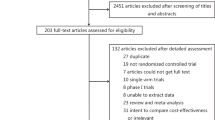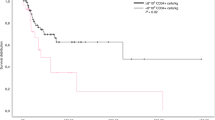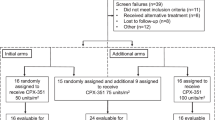Abstract
Sixty-four consecutive patients with locally advanced (n = 7) or metastatic breast cancer (n = 57), were treated with a combination of laevofolinic acid 100 mg m-2 plus 5-fluorouracil 340 mg m-2 i.v. on days 1-3, cyclophosphamide 600 mg m-2 i.v. on day 1 and epirubicin 90 mg m-2 i.v. on day 1. Epirubicin dose was progressively escalated by 10 mg m-2 per cycle up to 120 mg m-2 in the absence of dose-limiting toxicities. Granulocyte colony-stimulating factor (G-CSF) was given subcutaneously in order to prevent neutropenia. Epirubicin dosage could be increased to 100 mg m-2 in 53 patients (87%), to 110 mg m-2 in 31 patients (51%) and to 120 mg m-2 in 18 cases (30%). In most patients the dose-limiting toxicity was represented by myelosuppression. A statistically significant correlation was found between median white blood count (WBC) or absolute neutrophil count (ANC) nadir and epirubicin dose level (P = 0.009; P = 0.008). Moreover, a statistically significant correlation was observed between the number of chemotherapeutic cycles, nadir ANC and WBC and the occurrence of anaemia and thrombocytopenia of increasing severity. These data suggest the occurrence of progressive cumulative bone marrow toxicity. Although patients who reached different epirubicin levels showed differences in mean dose intensity, such differences were not statistically significant. No correlation was found between the increase in dose intensity and type, rate or duration of objective responses. In patients with metastatic breast cancer the overall response rate was 72% (95% CL 66-78%) with a 25% complete response rate. Median duration of response was 10 and 13 months respectively for complete and partial responses. All patients with locally advanced breast cancer had an objective response and underwent radical mastectomy. Projected median survival of the whole series of patients with metastatic breast cancer was 20 + months. These data demonstrate that the combination of 5-fluorouracil with laevofolinic acid, cyclophosphamide and epirubicin is very active against metastatic breast cancer. Use of G-CSF allows epirubicin dosage to be increased up to 120 mg m-2 cycle-1, but its use may be linked to the occurrence of sometimes severe cumulative haematological toxicity.
This is a preview of subscription content, access via your institution
Access options
Subscribe to this journal
Receive 24 print issues and online access
$259.00 per year
only $10.79 per issue
Buy this article
- Purchase on Springer Link
- Instant access to full article PDF
Prices may be subject to local taxes which are calculated during checkout
Similar content being viewed by others
Author information
Authors and Affiliations
Rights and permissions
About this article
Cite this article
Colucci, G., Romito, S., Gebbia, V. et al. Laevofolinic acid, 5-fluorouracil, cyclophosphamide and escalating doses of epirubicin with granulocyte colony-stimulating factor support in locally advanced and/or metastatic breast carcinoma: a phase I-II study of the Southern Italy Oncology Group (GOIM). Br J Cancer 72, 1245–1250 (1995). https://doi.org/10.1038/bjc.1995.494
Issue Date:
DOI: https://doi.org/10.1038/bjc.1995.494



